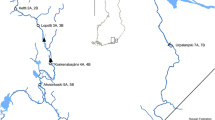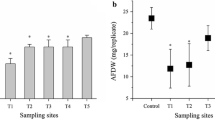Abstract
This research investigated the accumulation of polycyclic aromatic hydrocarbons (PAHs) by Chironomus riparius from sediments and transfer of these contaminants to bluegill, Lepomis macrochirus. Experiments were conducted in laboratory microcosms containing sediments spiked with either benzo[a]pyrene (BAP) or fluoranthene (FLU). Chironomids rapidly accumulated PAHs from sediments. Concentrations of BAP and FLU in chironomids increased with sediment concentration; however, FLU accumulated to a much greater extent. At sediment concentrations ranging from 47 to 4,040 μg/kg, levels of FLU in chironomids ranged from below detection to 181,000 μg/kg. In contrast, the maximum concentration of BAP measured in chironomids at similar sediment levels was 6,030 μg/kg. Levels of FLU and BAP in bluegill that were fed contaminated chironomids were generally low, indicating either low uptake or rapid metabolism of these compounds.
Bioturbation of sediments by chironomids decreased water clarity and released sediment-associated BAP to overlying water. BAP in water and in C. riparius increased significantly with chironomid density. In experiments where bluegill were exposed to BAP from water, direct contact with sediments, and chironomids, each source contributed to total body burden. The results of the experiments indicated that PAHs in sediments may be mobilized and made available to benthic invertebrates and fish.
Similar content being viewed by others
References
Boddington MJ, Miller DR, DeGreitas ASW (1979) The effects of benthic invertebrates on clearance of mercury from contaminated sediments. Ecotox Environ Safety 3:236–244
Dallinger R, Kautzky H (1985) The importance of contaminated food uptake for the heavy metals by rainbow trout (Salmo gairdneri): A field study. Oecologia (Berlin) 67:82–89
Dallinger R, Prosi F, Back H (1987) Contaminated food and uptake of heavy metals by fish: a review and a proposal for further research. Oecologia (Berlin) 73:91–98
Dobroski CJ Jr, Epifanio CE (1980) Accumulation of benzo[a]pyrene in a larval bivalve via trophic transfer. Can J Fish Aquat Sci 37:2318–2322
Eisler R (1987) Polycyclic aromatic hydrocarbon hazards to fish, wildlife, and invertebrates: A synoptic review. U.S. Fish Wildl Serv Biol Rep 85 (1.11)
Etnier DA (1971) Food of three species of sunfishes (Lepomis, Centrarchidae) and their hybrids in three Minnesota lakes. Trans Am Fish Soc 100:124–128
Gerould S, Landrum PF, Giesy JP (1983) Anthracene bioconcentration and biotransformation in chironomids: effects of temperature and concentration. Environ Pollut (Ser A) 30:175–188
Gower AW, Buckland PJ (1978) Water quality and the occurrence of Chironomus riparius Meigen (Diptera: Chironomidae) in a stream receiving sewage effluent. Freshwater Biol 8:153–164
Jimenez BD, Cirmo CP, McCarthy JF (1987) Effects of feeding and temperature on uptake, elimination and metabolism of benzo(a)pyrene in the bluegill sunfish (Lepomis macrochirus). Aquat Toxicol 10:41–57
Johnson AC, Larsen PF, Gadbois DF, Humason AW (1985) The distribution of polycyclic aromatic hydrocarbons in the surficial sediments of Penobscot Bay (Maine, USA) in relation to possible sources and to other sites worldwide. Mar Environ Res 5:1–16
Karickhoff SW, Morris KR (1985) Impact of tubificid oligochaetes on pollutant transport in bottom sediments. Environ Sci Technol 19:51–56
Landrum PF (1989) Bioavailability and toxicokinetics of polycyclic aromatic hydrocarbons sorbed to sediments for the amphipod Pontoporeia hoyi. Environ Sci Technol 23:588–595
Landrum PF, Eadie BJ, Faust WR (1991) Toxicokinetics and toxicity of a mixture of sediment-associated polycyclic aromatic hydrocarbons to the amphipod Diporeia sp. Environ Toxicol Chem 10:35–46
Larsson P (1985) Contaminated sediments of lakes and oceans act as sources of chlorinated hydrocarbons for release to water and sediments. Nature 317:347–349
Lee RF, Sauerheber R, Dobbs GD (1972) Uptake, metabolism, and discharge of polycyclic aromatic hydrocarbons by marine fish. Mar Biol 17:201–208
Leversee GJ, Giesy JP, Landrum PF, Gerould S, Bowling JW, Fannin TE, Haddock JD, Bartell SM (1982) Kinetics and biotransformation of benzo(a)pyrene in Chironomus riparius. Arch Environ Contam Toxicol 11:25–31
McCarthy JF, Jimenez BD (1985) Reduction in bioavailability to bluegills of polycyclic aromatic hydrocarbons bound to dissolved humic material. Environ Toxicol Chem 4:511–521
Maccubbin AE, Black P, Trzeciak L, Black JJ (1985) Evidence for polynuclear hydrocarbons in the diet of bottom-feeding fish. Bull Environ Contam Toxicol 34:876–882
Malins DC, McCain BB, Brown DW, Varanasi U, Krahn MM, Myers MS, Chen SL (1987) Sediment associated contaminants and liver diseases in bottom-dwelling fish. Hydrobiologia 149:67–74
Marcus JM, Swearingen GR, Williams AD, Heizer DD (1988) Polynuclear aromatic hydrocarbons and heavy metal concentrations in sediments at coastal South Carolina marinas. Arch Environ Contam Toxicol 17:103–113
Metcalfe CD, Cairns VW, Fitzsimons JD (1988) Experimental induction of liver tumors in rainbow trout (Salmo gairdneri) by contaminated sediments from Hamilton Harbor, Ontario. Can J Fish Aquat Sci 45:2161–2167
Muir DCG, Townsend BE, Lockhart WL (1983) Bioavailability of six organic chemicals to Chironomus tentans larvae in sediment and water. Environ Toxicol Chem 2:269–181
Neff JM (1979) Polycyclic aromatic hydrocarbons in the aquatic environment. Appl Sci Publ Ltd, London
Neff JM, Cox BA, Dixit D, Anderson JW (1976) Accumulation and release of petroleum derived aromatic hydrocarbons by four species of marine fish. Mar Biol 38:279–289
Niimi AJ, Dookhran GP (1989) Dietary absorption efficiencies and eliminatíon rates of polycyclic aromatic hydrocarbons (PAHs) in rainbow trout (Salmo gairdneri). Environ Toxicol Chem 8:719–722
Oris JT, Giesy JP Jr (1985) The photoenhanced toxicity of anthracene to juvenile sunfish (Lepomis spp.). Aquat Toxicol 6:133–146
Payne JF, Kicenick J, Fancey LL, Williams U, Fletcher GL, Rahimtula A, Fowler B (1988) What is a safe level of polycyclic aromatic hydrocarbons for fish: Subchronic toxicity study on the winter flounder (Pseudopleuronectes americanus). Can J Fish Aquat Sci 45:1983–1993
Rasmussen JB (1984) Comparison of gut contents and assimilation efficiency of fourth instar larvae of two coexisting chironomids, Chironomus riparius Meigen and Glyptotendipes paripes (Edwards). Can J Zool 62:1022–1026
Reichert WL, Eberhart BTL, Varanasi U (1985) Exposure of two species of deposit-feeding amphipods to sediment associated [3H] benzo[a]pyrene: Uptake, metabolism, and covalent bonding to tissue macromolecules. Aquat Toxicol 6:45–46
Reynoldson TB (1987) Interactions between sediment contaminants and benthic organisms. Hydrobiologia 149:53–66
Swartz RC, Kemp PF, Schults DW, Lamberson JO (1988) Effects of mixtures of sediment contaminants on the marine infaunal amphipod, Rhepoxynius abronius. Environ Toxicol Chem 7:1013–1020
Swartz RC, Schults DW, Dewitt TH, Ditsworth GR, Lamberson JO (1990) Toxicity of fluoranthene in sediment to marine amphipods: a test of the equilibrium partitioning approach to sediment quality criteria. Environ Toxicol Chem 9:1071–1080
Varanasi U, Reichert WL, Stein JE, Brown DW, Sanborn HR (1985) Bioavailability and biotransformation of aromatic hydrocarbons in benthic organisms exposed to sediment from an urban estuary. Environ Sci Technol 19:836–841
Wiederholm T (1984) Responses of aquatic insects to environmental pollution. In: Resh VH, Rosenberg DM (eds) The ecology of aquatic insects. Praeger, NY, pp 508–557
Author information
Authors and Affiliations
Rights and permissions
About this article
Cite this article
Clements, W.H., Oris, J.T. & Wissing, T.E. Accumulation and food chain transfer of fluoranthene and benzo[a]pyrene in Chironomus riparius and Lepomis macrochirus . Arch. Environ. Contam. Toxicol. 26, 261–266 (1994). https://doi.org/10.1007/BF00203550
Received:
Revised:
Issue Date:
DOI: https://doi.org/10.1007/BF00203550




